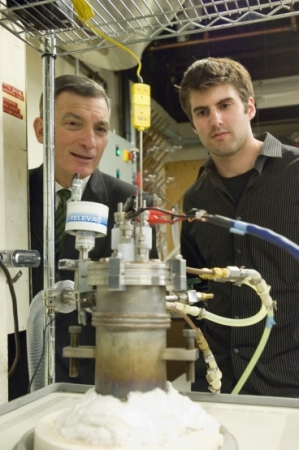Researchers at the MIT have developed a potential new technology for leveling the load in renewable energy sources. Intermittency of clean and renewable energy is a major disadvantage. Addressing this issue by leveling the erratic supplies will help increase the viability of these energy sources.
 Professor Donald Sadoway and Materials Processing Center Research Affiliate David Bradwell observe one of their small test batteries in the lab. The battery itself is inside the heavily insulated metal cylinder at center, which heats it to 700 degrees Celsius. Photo: Patrick Gillooly
Professor Donald Sadoway and Materials Processing Center Research Affiliate David Bradwell observe one of their small test batteries in the lab. The battery itself is inside the heavily insulated metal cylinder at center, which heats it to 700 degrees Celsius. Photo: Patrick Gillooly
The novel technology being developed by John F. Elliot Professor of Materials Chemistry, Donald Sadoway, and his team including David Bradwell, an MIT Materials Processing Center Research Affiliate, utilizes liquid batteries that can help level the load with better longevity and lower cost.
The battery contains materials that are inexpensive and easily available. The materials form three layers due to the difference in their densities. Many potential combinations were discovered. In one combination, the positive electrode was of antimony, the negative electrode was of magnesium, while the electrolyte was a salt mixture that contained magnesium chloride.
Sadoway had earlier worked on the electrochemistry of aluminum smelting and its concept inspired the new liquid battery idea, which can be considered as “reverse smeltering.” The delivery of current from the battery occurs when two electrons from magnesium atoms become ions and migrate to the positive electrode through the electrolyte. The ions get back two electrons and change back into magnesium atoms. These atoms then become an alloy with antimony. When recharging has to be done, electricity has to be supplied to the battery. During this phase the magnesium is driven out of the alloy with antimony to the negative electrode through the electrolyte.
The team has scaled up its tests from using shot glass-sized batteries to 6” wide batteries, which have 200 times more power-storage capacity.
The cost of storage for a certain amount of power will be a major consideration of the users of the liquid battery technology. The research team is further optimizing the system to decrease the present operating temperature from 700 °C (1,292 °F).
Sadoway and Bradwell have founded a company, Liquid Metal Battery, for commercializing the novel technology.
The results of the study were published in the Journal of the American Chemical Society.